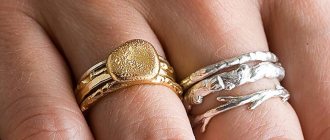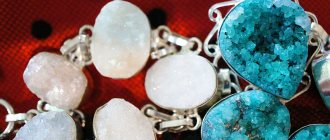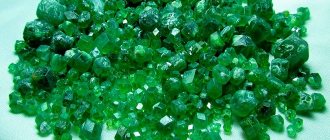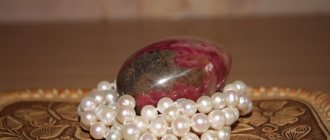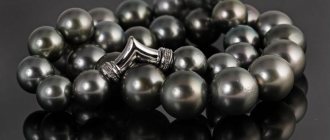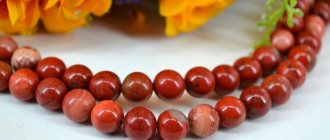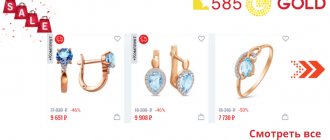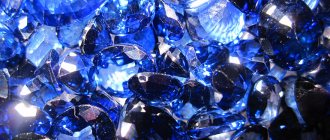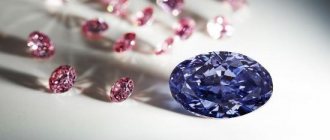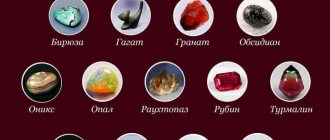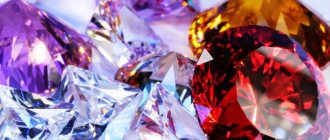Assessment systems
For a long time, there was no classification to evaluate the clarity of diamonds. But since the 50s of the last century, employees of the Gemological Institute of America (GIA) took up this issue closely and created the 4C grading system, which is still the basic one.
According to the new system, the characteristics that determine the value of the gem were assessed:
- diamond clarity;
- color;
- weight;
- cut.
Specialized institutions and certified specialists have the right to evaluate.
The most authoritative are:
- Supreme Diamond Council of Belgium;
- World Jewelry Confederation (Switzerland).
In our country, the Gemological Center of Moscow State University is considered the main appraiser.
Watch the video with interesting facts and tips on choosing a stone:
Diamond certificate
A GIA certificate can confirm the authenticity of a gem. Stones for evaluation are delivered anonymously, without information about the owner. After the procedure, a document is issued with a full description of all the characteristics of the gem and an indication of its value. Each copy is assigned an individual alphanumeric number, which reflects all parameters.
Diamonds are graded unbiased by the Gemological Institute of America, making the results 100% reliable.
The certificate must be kept in a place inaccessible to unauthorized people.
What happens after a diamond is appraised?
All of the above assigned classes are recorded after passing the examination. The specimen being examined is assigned a unique identification number. Its “parameters” are recorded in the database of the institute or organization that conducted the assessment. Also, the assessed diamond is assigned and issued a certificate confirming its authenticity and the previously described parameters.
If a precious mineral needs, for example, to be restored, then the organization carrying out this work (if not the one that carried out the assessment) must first contact the appraisal organization and warn it about the upcoming work.
After the work is completed, the contractor should send or transfer the restored stone to the organization that carried out the first assessment. She must re-evaluate the stone, make the necessary amendments to her database and issue a new certificate with an added detailed description of the work performed. After making all the changes, the appraisal organization transfers the stone with the document back to the contractor, who then gives the restored sample to the customer.
As a rule, the procedure is significantly simplified, because this issue is often dealt with by entire jewelry houses, which can evaluate the diamond and contact other appraisal organizations to carry out the necessary restoration work.
How to determine the clarity of a diamond
Flaws on a gem may be visible upon normal inspection without special equipment. To accurately evaluate a diamond, use a 10x magnification loupe. Only the stone is evaluated, without a frame.
After inspection, the gem is assigned to a particular class or group, according to the diamond purity scale.
What is diamond clarity?
Natural diamonds, created by nature, almost always contain coal or snow inclusions in their structure. The presence of inclusions is due to impurities, which also affect the color characteristics.
It is believed that perfect crystals do not exist in nature. Specimens with surface inclusions can be considered ideal. Such diamonds are polished or high-quality cut, thereby removing any defects.
The purity of the diamond depends on the number of inclusions, their location, and extent. That. The clarity of a diamond will be considered good if the stone contains a minimum number of small inclusions.
Victoria will tell you what cleanliness is:
Russian scale
The best quality is for diamonds of the first category, which do not have any defects. There are very few of them, estimated at millions of dollars. When classifying according to the Russian scale, the mass and number of faces are taken into account.
Classification by groups:
GIA Score
The GIA classification takes into account the characteristics of internal defects only. And superficial ones can be removed during processing. The best diamonds are considered to be IF - without inclusions. But they are rare. All classes are suitable for purchase except I 1, I 2, I 3.
Classification:
| Designation | Class | Characteristic |
| Internally Flawless | IF | Ideal, no inclusions. |
| Very Very Small Inclusions | VVS 1 VVS 2 | There are less than 3 very, very small light inclusions. |
| Very Small Inclusions | VS 1 VS 2 | Up to 3 dark very small inclusions or up to 6 light ones. |
| Small Inclusions | SI 1 SI 2 SI 3 | Up to 8 small inclusions. |
| Imperfect | I 1 I 2 I 3 | Large multiple inclusions, cracks. |
Rappoport scale
To determine the market value, the Gemological Institute of America regularly creates the Rappoport scale, based on the current price list. One page displays prices for round diamonds, and the second page displays prices for other shapes.
Prices are updated every 2 weeks. Therefore, for ease of calculation, online calculators have been created.
Correspondence of purity scale indicators
The table shows the relationship between the Russian scale and the GIA scale.
Gems from groups 1–6 have jewelry value. The rest are classified as technical and used in industry.
Criteria for evaluation
You don't have to be a gemologist to determine the clarity of a diamond. The main thing is to understand what characteristics are taken into account when studying a stone. When examining a gem, the following criteria are important:
- number of foreign inclusions;
- location;
- the presence of cracks on the surface of the stone;
- the presence of other flaws.
Defects are divided into two categories: internal and external. The first group are flaws that do not go away even after careful polishing or disappear, but the stone loses weight. External defects are eliminated during processing of the mineral and affect the quality of the crystal.
Characteristics of a diamond include the color of the stone. Shades of green, yellow, gray, and brown reduce the cost of the mineral.
A colorless diamond or one colored evenly in one color is valued - emerald, blue, pink
What determines the color of the stone
Color and shade depend on the chemical composition of the mineral:
- the blue tint is created by boron impurities;
- the green color comes from thorium and uranium;
- black - thanks to graphite;
- yellow, brown – nitrogen;
- the pink tint occurs from exposure to high temperatures.
Saturation depends not only on the absence of foreign inclusions, but also on the characteristics of the crystal lattice. A more saturated color is found in those stones that have a dense crystal lattice with a small distance between carbon molecules.
Russian scale
In Russia, diamonds are divided into types based on color using 3 grading scales.
Table for stones with 17 faces:
| Group | Description |
| 1 | White, barely bluish tint |
| 2 | Slight yellowish tint |
| 3 | White with visible color tint or yellow |
| 4 | Brown |
Table for stones with 57 facets weighing up to 0.299 carats:
| Group | Description |
| 1 | White, barely bluish tint |
| 2, 3 | Slight yellowish tint |
| 4 | White with visible color tint |
| 5 | Yellow |
| 6, 7 | Brown |
Table for stones with 57 facets weighing from 0.300 carats:
| Group | Description |
| 1 | Bluish white color |
| 2, 3 | With an almost invisible tint |
| 4, 5 | With barely noticeable yellowness |
| 6, 7 | With a distinct shade |
| 8 | Yellow |
| 9 | Brown |
GIA Score
The GIA rating system provides 2 scales:
- for colorless;
- for colored (fancy) diamonds.
The sample is compared to a diamond standard and assigned a letter designation from D to Z, where D is colorless and Z is yellow. A yellowish tint begins to appear from the letter K.
Colored diamonds are valued according to the principle: the darker, the more expensive.
Correlation of color scale indicators
The table shows how the color scales relate to each other.
Which diamond ring in gold is better to buy?
Nowadays, a diamond ring ranks high on the wish list of modern girls, and this is not surprising.
But how to choose the right product, what should you pay attention to? Which diamond ring is better to buy, especially if it is a gift?
Small stones (about 0.05 carats) look attractive as “constellations”: unusual designs, classic “paths” running across the entire circumference of the ring, reminiscent of star scatterings, amaze with their gentle radiance.
Rings with diamonds that weigh less than one carat look very beautiful and elegant. The frame minimally holds the stone, all the beauty of which can be seen from any side. For this type of product, high-purity gems with an ideal cut are used. But such products are usually not given without a serious reason.
Considering the above, it is not difficult to understand which gold will best “show off” a diamond: white looks great with colorless, “cold” stones from the first color groups, and red goes well with “warm” stones from the last groups.
With the help of this knowledge, you can independently navigate when purchasing jewelry with gems. It is difficult to answer unequivocally which diamonds are best to buy. It all depends on the amount the potential buyer expects. You can buy a piece of jewelry with a stone of high purity, correct cut and high carat value, or you can buy a ring with a diamond “path”, which will be more affordable, and also enjoy the play of light on these jewelry.
Decoding tags
The tag displays the main parameters: the number of stones, their shape, weight, number of facets, color and clarity classes.
Clearly shown in the image:
If possible, it is better to choose a diamond without visually detectable defects. If flaws are visible on crystals up to 0.300 carats, then their purity is 5, 6 or more. If flaws are visible on stones over 0.300 carats, then the purity is 7, 8 or more.
You can find the designations 2/2, 2/3, 3/3, 4/4, 4/5, 5/5, etc. on the tag - these numbers mean color (first digit) and purity (second digit).
- The 1/1 diamond is considered the most ideal; it is extremely rare and incredibly expensive. Next to it is specimen 2/2, which has very minor defects visible only under a magnifying glass.
- Samples with the designations 3/3, 4/4, 6/6 are more popular among the population and are purchased most often. Defects are not visible without a magnifying glass.
- Gemstones with a clarity of 3 to 6 are considered the most investment grade. Their prices remain approximately the same.
- For those who are limited in funds, option 6/6 is suitable - this is the solution, because the stone looks quite decent, but is not too expensive.
By color it is better to choose F, G, H according to GIA.
Learn more about evaluating a diamond and determining its characteristics in the video:
Color or purity: which is more important?
When choosing jewelry, both characteristics are important, but which one to focus on is determined individually:
- You need to choose according to purity if you intend to have a frame made of yellow gold. It will absorb yellowish shades, thereby brightening the crystal. If the gem is of poor quality, it will appear dirty.
- You need to focus on color if you intend to have a white frame. If the stone has additional shades, a white frame will enhance them. This product will look cheap.
Buy gems from reputable jewelry stores to avoid fraud. Please review supporting documentation before purchasing.
Were you previously familiar with diamond grading scales? Share your experience. Share the article with your friends on social networks. All the best.
What is a quality certificate
A certificate is a document that directly confirms the true quality of a diamond. It contains the following information:
- diamond clarity designation;
- the presence of deficiencies and their number;
- internal arrangement of foreign elements of the mineral.
Many companies involved in the jewelry business have the right to issue a certificate for jewelry. However, there are a couple of laboratories whose assessment meets the highest standards. Both of them are based in America. This:
- Gemological Institute.
- Jewelers Association.
Buying a precious stone is an infrequent event in the lives of ordinary people, and therefore it must be done carefully and carefully. If it is not possible to invite a specialist with you to the jewelry store to help determine the clarity of the stone, you can do this yourself. Knowing the characteristics of real diamonds and the rules for assessing their main parameter - the presence of impurities, it will not be difficult to find out the condition of the jewelry, and therefore the money on it will not be wasted.
